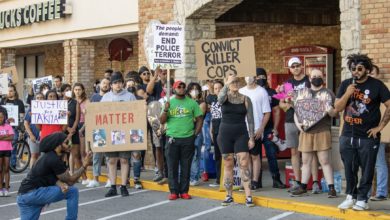The massive manhunt continues for Christopher Jordan Dorner, and already the police have opened fire on three innocent people, two Latina newspaper workers and a Black man, in two separate incidents. The area police are well known for their “shoot first, ask questions later” approach, and this has only been magnified in the present moment. Given the muted response from the media and local officials, it is clear that they do not intend to hold these officers responsible for the shooting of innocents.
A former Los Angeles police officer, Dorner has declared war on his former employer, launching deadly attacks on police officers and their families in retaliation for what he describes as the department’s rampant corruption, racism and abuse. Dorner was fired, allegedly for making a false claim, after he reported another officer for kicking a homeless person in the process of making an arrest.
After exhausting a number of channels to appeal his firing, Dorner issued a long “Last Resort” manifesto declaring that the only way to clear his name, and defend his honor, was to launch a violent campaign against the LAPD. The main theme of the manifesto is that there is a concerted effort reaching all the way up the LAPD’s command structure to cover up police brutality and racism.
Predictably the police are painting Dorner as simply an unhinged madman. They have denied all his allegations of abuse and corruption. The corporate media has largely followed suit, essentially refusing to take seriously his claims.
That Dorner has mental health issues, and has “snapped” is fairly clear—he has admitted so himself. But he has also earned a good deal of sympathy from oppressed youth and Black communities in particular, whose lived experiences confirm the description of the police that Dorner gives in his lucid manifesto. A New York Times headline admitted, “Shooting Suspect’s Racism Allegations Resound for Some.”
Dorner’s Manifesto
While we cannot independently verify Dorner’s particular allegations, it is impossible to classify his manifesto as the rantings of a madman. In his manifesto, Dorner exposes the notion that the LAPD is somehow a reformed institution compared to its notorious white supremacist past. He names many officers from the “bad years,” including those implicated in well-known scandals, who are still on the force and in fact in leading positions.
Even if the composition of the LAPD has changed in the last few decades, its fundamental relationship with Black and Latino communities has not, and he calls out officers of color who perpetuate these patterns of violence and abuse.
He condemns the infamous “blue wall of silence,” which allows officers to violate the law with impunity and punishes the few (such as himself) who attempt to blow the whistle.
Dorner alludes to racist taunts and insults he suffered as a child, something that hardened in him a will and rage to fight back. He recounts racist behavior by fellow officers, including the open use of racist epithets around Black officers. Instead of the officers being punished, he claims he was disciplined for challenging these racists. Again, this is easily believable.
LAPD’s greatest ‘hits’
Dorner has launched what he describes as a campaign of “unconventional and asymmetric warfare.” He has killed three people, including a police officer and the daughter of a former officer who had represented him—Dorner says disingenuously—in his legal appeal of his firing. He has wounded another officer. For days, law enforcement agencies have deployed thousands of officers in a massive manhunt in an attempt to track him down.
The LAPD has a long and sordid history, and is probably the police department most associated in the public mind with rampant lawlessness and white supremacy.
The LAPD was one of the first police departments to take a paramilitary form when it established the first SWAT Team in America in 1967, which “proved” its worth by launching a four-hour attack and siege on Black Panther headquarters in Los Angeles. This assault went along with a spying operation, operating from 1970-1981, which illegally infiltrated and harassed progressive groups.
In response to the growth of street organizations (gangs) and the drug trade in the 1980s, the LAPD unleashed the “Community Resources Against Street Hoodlums” or CRASH units on poor Black and Latino neighborhoods. CRASH was a so-called cowboy justice unit that has been connected to widespread corruption and abuse in their activities.
LAPD “justice” made its major debut on the national scene in 1991 when a video surfaced of Rodney King being viciously beaten by a group of officers. The Christopher Commission, which investigated LAPD practices following the King beating, found that over 25 percent of officers told investigators that “officers’ prejudice” may result “in use of excessive force.” In addition, nearly 25 percent believed racist attitudes to be a key problem in police-community relations. If these were the perceptions of the officers themselves, one can only imagine what the percentages would be in Black and Latino neighborhoods.
The report also concluded, in artful language, that the LAPD’s internal culture tolerated and failed to punish officers with a documented pattern of brutality. Christopher Commission investigators examined police communications and found some real gems about police activities such as:
“Did U arrest the 85yr old lady or just beat her up?” Response: “we just slapped her around a bit…shes getting [medical treatment] right now.”
And:
“I left a 14yr old girl who I met yesterday handcuffed on my chin up bar wearing nothing but a blindfold and salad oil”
During the O.J. Simpson trial, tapes of Detective Mark Fuhrman revealed LAPD “best practices:”
“When I was working gang…they wouldn’t talk. So, I would go pick up three or four…bring them to the station, take one in the basement and beat the dogs— out of him, without even asking him a question. …That’s how you get information.”
Given the LAPD’s notorious record, it is no mystery why Dorner has tapped into a vein of sympathy during the manhunt, and already emerged as a sort of folk hero among some online and in the streets of oppressed neighborhoods. Even those who do not support his individual actions understand that it was a lifetime of experiencing racism, and being told to swallow the LAPD’s bigoted and corrupt culture, that pushed him over the edge.






